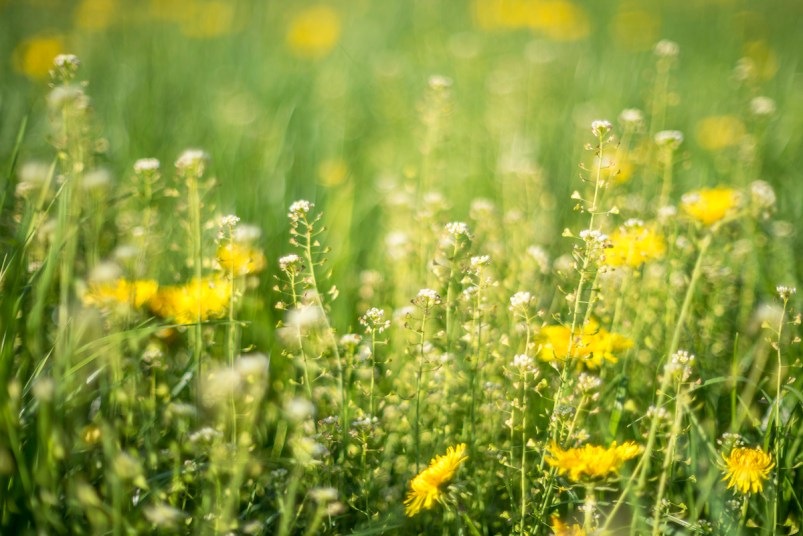How to Relieve Itchy Eyes from Seasonal Allergies, According to an Allergist

Just when we’re ready to enjoy some warmer weather and longer days, allergy season creeps in like an anvil on our spring — making this one of the most difficult and uncomfortable times of the year for many. A major concern is that allergies can make our eyes and nose very itchy, but as we all know, it is not advisable to touch our faces at this time — especially in public — so we spoke with allergist Dr. Tania Elliott to get some helpful tips on how to combat the allergy itch.
What exactly causes seasonal allergies?
During spring we’re exposed to airborne pollen from wind-pollinated plants that is so microscopic, it stays suspended in the air. When we go outside, the pollen sticks to us in places, such as in between our eyelashes, causing chemical reactions and the release of histamines, which are responsible for the itchiness, redness, and sneezing. What’s worse, pollen is so small that it can continue to irritate us even after we’ve gone indoors.
How to tell the difference between allergies, a cold, and COVID-19?
Allergies impact the upper airways — causing nasal decongestion, itchy eyes, and runny nose. You might experience a cough, which is due to increased drainage of mucus down to the back of your throat. COVID-19 affects the lower airways in the lungs, and symptoms include a dry cough, fever, shortness of breath, and loss of taste, none of which are symptoms of allergies.
“The highest degree of overlap of symptoms of an infection to allergies is with a cold, because both cause the release of the chemical histamine,” explains Dr. Elliott. “The key way to differentiate is that allergies never cause a fever or swollen lymph nodes, and both of those symptoms would signify an infection.” Additional symptoms typical of allergies would be headache and fatigue, but not muscle aches or pains.
Try an eyelash scrub.
If your eyes are feeling itchy, Dr. Elliott suggests creating a light eyelash scrub by using baby shampoo diluted with warm water and a cotton swab or disposable mascara wand to softly brush away microscopic pollen in between your lashes “This is different than a face wash as we should be avoiding the eye area with most face washes, and with a typical wash or makeup remover we might not be getting in between the lashes, which is where pollen stores and continues to irritate you even after you’ve gone inside,” she explains.
What about makeup?
“[Wearing] makeup is fine, just avoid sticky moisturizers or face makeup that pollen may cling to easier and avoid false eyelashes or glue, which may be more susceptible to trapping pollen,” says Dr. Elliott. Plus, you can’t scrub false eyelashes, which is the best way to remove pollen from the eyes.
Wear sunglasses and hats — even when it’s cloudy.
It seems obvious to wear sunglasses and a wide brim hat on sunny days, but Dr. Elliott recommends to do the same even on cloudy days. “Pollen counts can actually be highest on cloudy days right after a rainstorm,” she says. “After a weather event, pollen can get aggravated and higher numbers are suspended in the air.” Wearing glasses and wide brim hats outdoors, no matter the weather, can act as a barrier and protect us.
Don’t reach for the allergy pills.
When it comes to treating allergies, many of us reach for over-the-counter medications such as Benadryl. “The issue with these types of general antihistamines is that they impact the entire body by crossing into the blood-brain barrier and can cause many side effects, such as drowsiness and degradation of sleep quality,” says Dr. Elliott. So even if you find some relief in the affected area, the rest of your body is being unnecessarily treated, too.
Try targeted allergy relief instead.
Since general antihistamines can cause us more harm than good, Dr. Elliott recommends treating the issues at the source instead. “Pataday eye drops ($18.96, Amazon) used to be available by prescription only — but are now available over the counter. Pataday is an antihistamine solely for itchy eyes and provides fast relief,” she says.
For nasal symptoms, Dr. Elliott recommends a nasal steroid spray like Nasacort Allergy Relief Spray ($24.84, Amazon), but you have to use these consistently for 5-7 days before you start to see an improvement. “These sprays need to be used consistently, not on an as-needed basis, and using them properly is the key to seeing results,” she says.
Try daily contacts if you’re a contact wearer.
If you’re a contact wearer, you might benefit from daily throw-away lenses. If you prefer longer use lenses, be sure to wash your contacts thoroughly and often with clean hands and fresh solution and to swap to glasses when needed.
What if we’re itchy in public?
It is not advisable to touch your eyes, nose, or face when in public at this time, which is bad news for allergy sufferers. “The great thing about Pataday is that you can take it on the go, so if you’re in public and you’re experiencing itchiness, you can still find relief without scratching,” says Dr. Elliott.
Change clothes when you get home.
The clothes we wear outside can be carriers of pollen, which we in turn bring into our homes. Dr. Elliott suggests we change immediately when we walk inside. “I recommend to shower as well, as this will remove excess pollen from our skin and hair,” she says.












